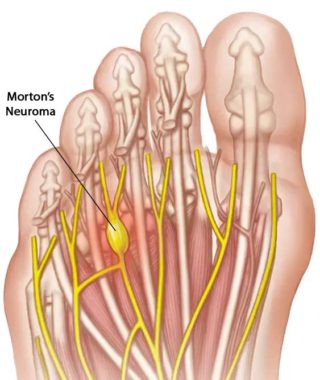A neuroma is a thickening of nerve tissue that may develop in various parts of the body. The most common neuroma in the foot is Morton’s neuroma, which occurs at the base of the third and fourth toes. It is sometimes referred to as an intermetatarsal neuroma. “Intermetatarsal” describes its location, in the ball of the foot between the metatarsal bones (the bones extending from the toes to the midfoot). Neuromas may also occur in other locations in the foot. The thickening or enlargement of the nerve that defines a neuroma is the result of compression and irritation of the nerve. This compression creates swelling of the nerve, eventually leading to permanent nerve damage.
Symptoms of Morton’s Neuroma

If you have Morton’s neuroma, you will probably have one or more of these symptoms where the nerve damage is occurring:
- Tingling, burning, or numbness.
- Pain.
- A feeling that something is inside the ball of the foot, or that there’s a rise in the shoe or a sock is bunched up.
The progression of a Morton’s neuroma often follows a pattern. Symptoms begin gradually and at first, they occur only occasionally. Wearing narrow-toed shoes or performing certain activities can irritate the Morton’s neuroma. The symptoms may be made to go away temporarily by massaging the foot or by avoiding irritating shoes or activities. Over time the symptoms progressively worsen and may persist for several days or weeks. The symptoms become more intense as the neuroma enlarges and the temporary changes in the nerve become permanent.
What Causes a Neuroma?
Anything that causes compression or irritation of the nerve can lead to the development of a neuroma. One of the most common offenders is wearing shoes that have a tapered toe box, or high-heeled shoes that cause the toes to be forced into a restricting toe box.
People with certain foot deformities–bunions, hammertoes, or flatfeet–are at higher risk for developing a neuroma. Other potential causes are activities that involve repetitive irritation to the ball of the foot such as running or racquet sports. An injury or another type of trauma to the area may also lead to a neuroma.
Diagnosis
To arrive at a diagnosis, the doctor will obtain a thorough history of a patient’s symptoms and examine the foot. During this examination, the doctor attempts to reproduce the symptoms by manipulating the foot. Other tests may be performed. X-rays may be taken to evaluate any deformity of the metatarsals. Diagnostic ultrasound may also be utilized to positively identify the neuroma.
The best time to visit Corrigan Podiatry is early in the development of symptoms. Early diagnosis of Morton’s neuroma greatly lessens the need for more invasive treatments and may preclude surgery.
